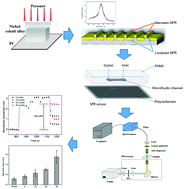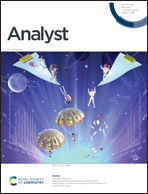LMP1 gene detection using a capped gold nanowire array surface plasmon resonance sensor in a microfluidic chip
Abstract
Surface plasmon resonance (SPR) nanowire array chips with a microfluidic system are an effective detection method for a rapid test device. This study investigated a capped gold nanowire array and a microfluidic test platform to provide a fundamental understanding of the kinetic binding of SPR nanowires and the surface gold refractive index. The device sensitivity of the SPR nanowire array was 485 nm RIU−1 and the detection limit was 4.1 × 10−5 RIU. Moreover, a kinetic binding analysis also indicated that a peak shift resulted from a specific hybridization of the target molecule with the immobilized probe on the gold nanostructures. The peak shift (red-shift) value of latent membrane protein 1 (LMP1) DNA was 2.21 nm. The results demonstrated that this new method had high sensitivity to detect amplified DNA products without labeling or complex sample treatment. The SPR nanowire chip can detect the PCR products at lower cycle numbers compared to gel electrophoresis due to probe and DNA specificity. Furthermore, the mechanisms of SPR nanowire array fabrication and the detection of the LMP1 gene were studied. The findings can assist in improving the biosensing of DNA-amplified products and in developing rapid detection devices with a small-footprint nanostructured SPR chip.



 Please wait while we load your content...
Please wait while we load your content...